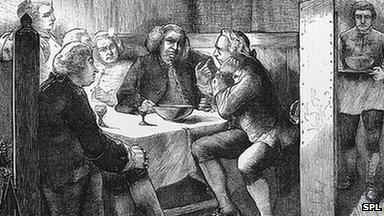English language 'originated in Turkey'
- Published

Modern Indo-European languages - which include English - originated in Turkey about 9,000 years ago, researchers say.
Their findings differ from conventional theory that these languages originated 5,000 years ago in south-west Russia.
The New Zealand researchers used methods developed to study virus epidemics to create family trees of ancient and modern Indo-European tongues to pinpoint where and when the language family first arose.
Their study is reported in Science.
A language family is a group of languages that arose from a common ancestor, known as the proto-language.
Linguists identify these families by trawling through modern languages for words of similar sound that often describe the same thing, like water and wasser (German). These shared words - or cognates - represent our language inheritance.
According to the Ethnologue database, more than 100 language families exist.
The Indo-European family is one of the largest families - more than 400 languages spoken in at least 60 countries - and its origins are unclear.
The Steppes, or Kurgan, theorists hold that the proto-language originated in the Steppes of Russia, north of the Caspian Sea, about 5,000 years ago.
The Anatolia hypothesis - first proposed in the late 1980s by Prof Colin Renfrew (now Lord Renfrew) - suggests an origin in the Anatolian region of Turkey about 3,000 years earlier.
To determine which competing theory was the most likely, Dr Quentin Atkinson from the University of Auckland and his team interrogated language evolution using phylogenetic analyses - more usually used to trace virus epidemics.
Fundamentals of life
Phylogenetics reveals relatedness by assessing how much of the information stored in DNA is shared between organisms.
Chimpanzees and humans have a common ancestor and share about 98% of their DNA. Because of this shared ancestry, they cluster together on phylogenetic - or family - trees.
Like DNA, language is passed down, generation to generation.
Although language changes and evolves, some linguists have argued that cognates describing the fundamentals of life - kinship (mother, father), body parts (eye, hand), the natural world (fire, water) and basic verbs (to walk, to run) - resist change.
These conserved cognates are strongly linked to the proto-language of old.
Dr Atkinson and his team built a database containing 207 cognate words present in 103 Indo‐European languages, which included 20 ancient tongues such as Latin and Greek.
Using phylogenetic analysis, they were able to reconstruct the evolutionary relatedness of these modern and ancient languages - the more words that are cognate, the more similar the languages are and the closer they group on the tree.
The trees could also predict when and where the ancestral language originated.
Looking back into the depths of the tree, Dr Atkinson and his colleagues were able to confirm the Anatolian origin.
To test if the alternative hypothesis - of a Russian origin several thousand years later - was possible, the team used competing models of evolution to pitch Steppes and Anatolian theory against each other.
In repeated tests, the Anatolian theory always came out on top.
Commenting on the paper, Prof Mark Pagel, a Fellow of the Royal Society from the University of Reading who was involved in earlier published phylogenetic studies, said: "This is a superb application of methods taken from evolutionary biology to understand a problem in cultural evolution - the origin and expansion of the Indo-European languages.
"This paper conclusively shows that the Indo-European languages are at least 8-9,500 years old, and arose, as has long been speculated, in the Anatolian region of what is modern-day Turkey and spread outwards from there."
Commenting on the inclusion of ancient languages in the analyses, he added: "The use of a number of known calibration points from 'fossil' languages greatly strengthens the conclusions."
However, the findings have not found universal acceptance. Prof Petri Kallio from the University of Helsinki suggests that several cognate words describing technological inventions - such as the wheel - are evident across different languages.
He argues that the Indo-European proto-language diversified after the invention of the wheel, about 5,000 years ago.
On the phylogenetic methods used to date the proto-language, Prof Kallio added: "So why do I still remain sceptical? Unlike archaeological radiocarbon dating based on the fixed rate of decay of the carbon-14 isotope, there is simply no fixed rate of decay of basic vocabulary, which would allow us to date ancestral proto-languages.
"Instead of the quantity of the words, therefore, the trained Indo-Europeanists concentrate on the quality of the words."
Prof Pagel is less convinced by the counter-argument: "Compared to the Kurgan hypothesis, this new analysis shows the Anatolian hypothesis as the clear winner."
- Published14 April 2011
- Published11 December 2009
- Published26 February 2009